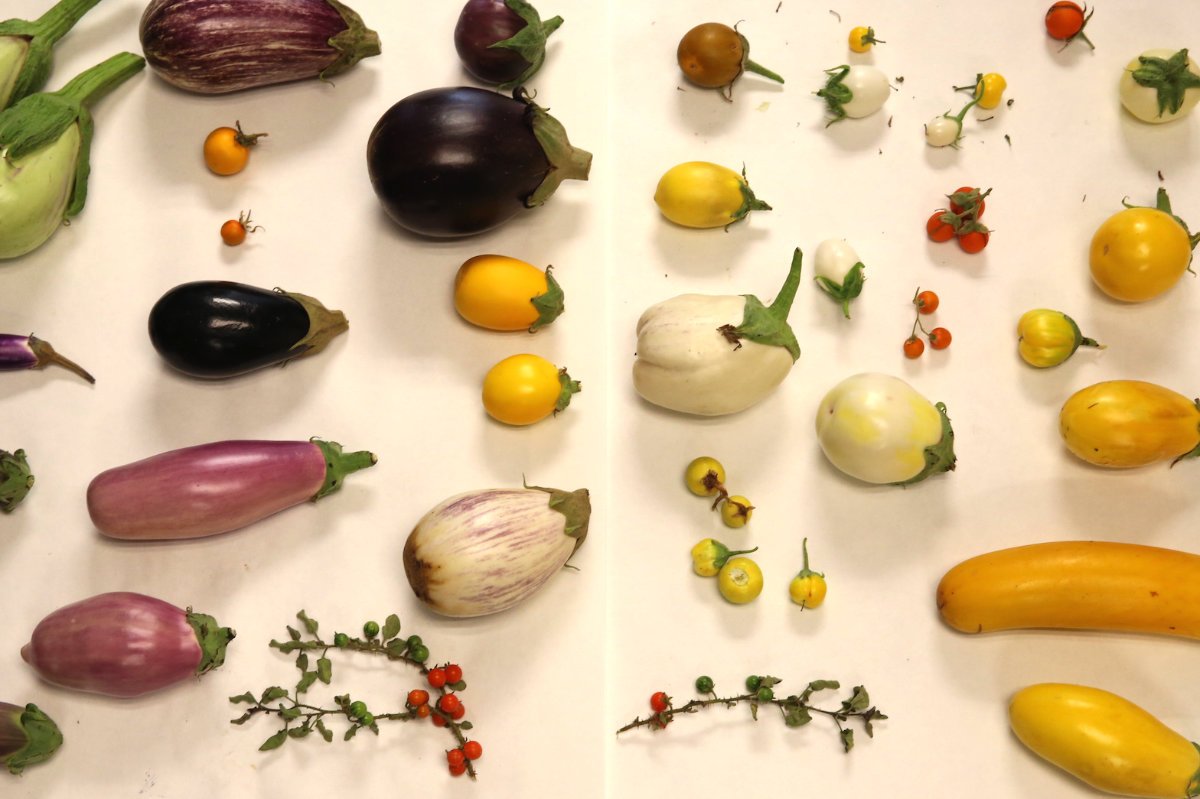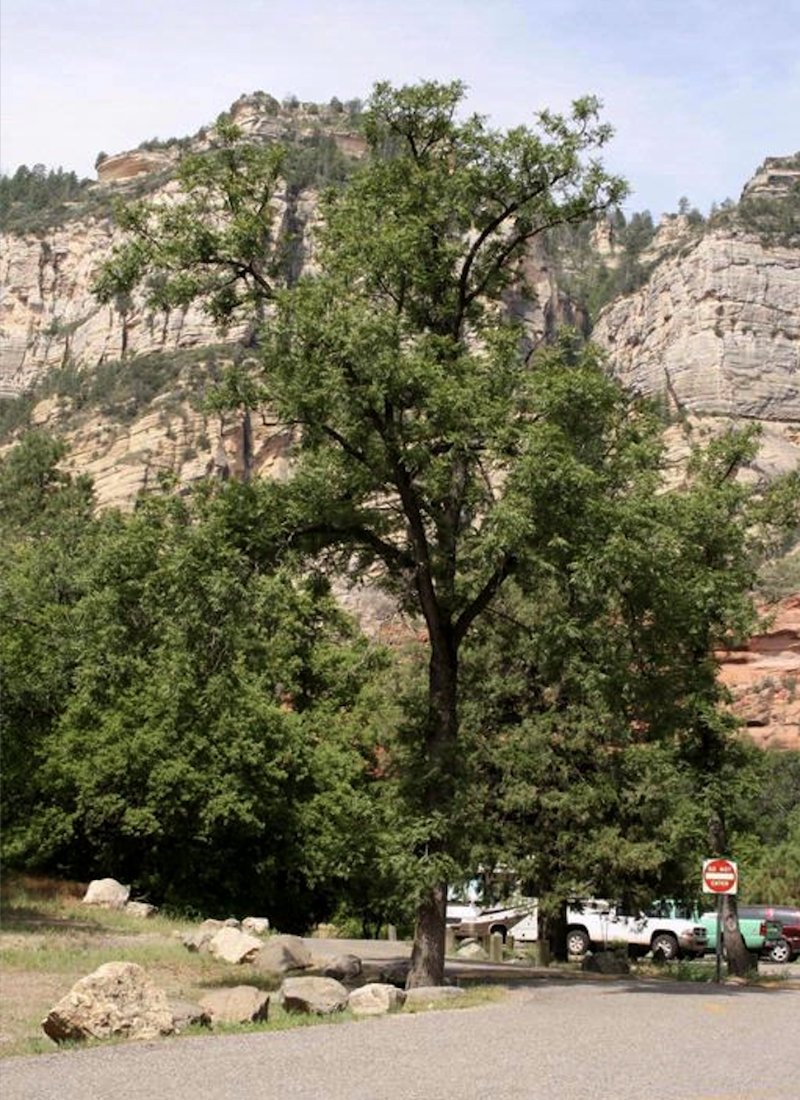The hardy wild cousins of domesticated crops can teach us how to adapt to a hotter, more unpredictable future.

The hardy wild cousins of domesticated crops can teach us how to adapt to a hotter, more unpredictable future.
April 22, 2024

Examples of crops and their wild relatives. (Photo courtesy of the Global Crop Diversity Trust)
In the rugged Tumacácori mountain region 45 minutes south of Tucson, the Wild Chile Botanical Area (WCBA) was established in 1999 to protect and study the chiltepin pepper—the single wild relative of hundreds of sweet and hot varieties including jalapeño, cayenne, and bell peppers, found on dinner plates worldwide.
The isolation of this ecologically rich archipelago of peaks, located in a “sea” of desert that stretches from northern Mexico into southern Arizona, means that plants grow here that don’t grow anywhere else. Its 2,800 acres—the first protected habitat for the wild relatives of crops in the United States—now shelter not just a single pepper but at least 45 different species.
Between 2021 and 2022, the Borderlands Restoration Network (BRN), an Arizona-based conservation non-profit, worked with the U.S. Forest Service to identify and collect other wild relatives of crops in this area. The idea behind the project was to build food security in a world where all climate models are pointing to hotter and dryer extreme conditions.
“You have this dramatic topography that provides all these different ecological niches for different things to grow,” said Perin McNelis, 36, native plant program director at the BRN. “Where better to start than an area that is already hot and dry, with all these wild relatives that are really adapted to conditions that will be more widespread in the future.”
Crop wild relatives, or CWRs for short, are the hardy wild cousins of domesticated crops. In the U.S. alone, thousands of crop wild relatives exist in their natural habitats, often thriving in harsh conditions. In Arizona this includes wild species of onion, wheat, squash, strawberry, grape and many other important crops. Increasingly, farmers and scientists are looking at them as reservoirs of genetic diversity with traits that can be bred into domesticated crops to improve drought, heat, and disease resistance—and perhaps serve as the key to the future of farming.
“What makes them important is they have traits that can help crops be more adapted and resilient to climate change,” said Stephanie Greene, a retired plant geneticist for the U.S. Department of Agriculture’s (USDA) Agricultural Research Service.
Erin Riordan, a conservation research scientist at the Arizona-Sonora Desert Museum outside Tucson, works to expand the regional food system to include dryland-adapted plants such as agave, mesquite, prickly pear, and tepary beans with low-water use agricultural practices. For instance, tepary beans—a tiny brown bean with a sweet chestnut flavor—require about 1/5 the water of pinto beans.
Arizona is the third driest state in the U.S. It also has the highest diversity of crop wild relatives due to the state’s wide-ranging topography and habitats, “from low deserts to high elevation alpine, to everything in between,” said Riordan. One thousand of the estimated 4,500 CWRs in the U.S. are found in the state, including desert-adapted relatives of critical domesticated foods—not just peppers, but also tomatoes, squash, amaranth, beans, corn, and wheat.

An Arizona Walnut tree. (Photo CC-licensed by Whitney Cranshaw, Colorado State University.)
Wild cotton grows in the parched grasslands of the Sonoran Desert, surviving without irrigation, pesticides, or other human inputs that domesticated cotton depends on. The wild Arizona walnut, found in desert riparian areas, has been used as a rootstalk for domesticated walnut trees to increase their tolerance to drought and diseases.
Currently, 44 percent of the world’s food is produced in arid and semi-arid lands. According to a 2017 report from the Food and Agricultural Organization of the United Nations, “80 percent of global cropland and 60 percent of global food output could be markedly affected by climate change, particularly in arid and semi-arid areas.” Riordan said protecting desert-adapted CWRs will be particularly important in a changing climate.
One issue complicating the use of wild relatives as a solution, however, is that these banks of genetic resilience are under threat through habitat destruction and global biodiversity loss caused by development and climate change. A 2020 paper in the National Academy of Sciences’ journal found that over half of the 600 CWRs identified in the study were either endangered or threatened. When a wild species goes extinct, so do the evolutionary traits that have allowed it to survive environmental extremes.
While the momentum for studying and conserving crop wild relatives has grown in recent years, few CWR species are protected at either a state or federal level. Arizona has been at the forefront of conservation efforts, protecting CWRs on public lands like the WCBA, at botanical gardens like at the Desert Museum, and at seed banks.
Last year was the world’s hottest summer on record; in Arizona, temperatures routinely exceeded 110 degrees. Across the state, crops withered in the punishing dry heat, and farmers left land fallow amid statewide water cutbacks driven by a historic megadrought.
“These last few years are indicative of the sorts of extreme conditions that are increasingly becoming the new norm,” Riordan said. “Arizona farmers have always experienced periodic drought and bouts of heat, but these events are happening with greater frequency, becoming more severe, and lasting longer.”
At the same time, other sources of water are becoming increasingly scarce in the west, putting stress on farmers and making some crops untenable. Last year, Arizona’s allotment from the Colorado River was cut by 21 percent.
“These last few years are indicative of the sorts of extreme conditions that are increasingly becoming the new norm.”
Benjamin Ruddell, director of the National Water-Economy Project, said that Colorado River water shortages left large areas of farmland in Arizona unsowed, a bellwether of things to come. “Up to 40 percent of farmland has been fallowed in some parts of Arizona,” he wrote in an email. Additionally, in some parts of the Southwest, states are paying farmers to fallow their fields to save water.
According to the Arizona Department of Water Resources, three quarters of Arizona’s total water supply is used for agriculture. “It’s going to be increasingly less feasible to irrigate things,” said Riordan. “If you’re not relying on surface flows, you’re relying on fossil water [groundwater], and we don’t have enough rain to be recharging.”
Dr. Michael Kotutwa Johnson, a Hopi dryland farmer and academic, pointed out that for millennia, Hopi farmers have successfully farmed, without irrigation, on ancestral lands that receive an average of 10 inches of rain or less per year. Farmers plant seeds deep in the soil, use passive rainwater harvesting, and rely on hardy desert-adapted seeds. “Our seeds are very resilient,” said Johnson. “They are just amazing in the way they can survive heat and lack of irrigation.”
Johnson said that unlike conventional farming, every aspect of Hopi farming has been refined to retain soil moisture with agricultural practices and crops that fit the environment, not the other way around.
Counter to this approach, many crops grown in Arizona require vast amounts of water and are maladapted to the environment, Johnson said. “As the temperature increases in Arizona, more water will be needed for commodity crops like cotton and alfalfa,” he said. “Those two crops are not place-based and will require even more water in the future.”
For Johnson, statewide water scarcity will require a move away from these water-thirsty crops towards desert-adapted varieties. “We need crops that use less water,” he said.
“Our seeds are very resilient. They are just amazing in the way they can survive heat and lack of irrigation.”
Author and ethnobotanist Gary Nabhan has been studying crop wild relatives for over 50 years. According to Nabhan, plant breeders and agronomists have been slow to accept the fact that we need desert-adapted crops, even as all signs point to a hotter, dryer future. “For nearly a century, crop wild relatives were neglected because plant breeders did not need drought and heat tolerance as long as they had plenty of irrigation water,” said Nabhan.
As a university student in the late ‘70s, Nabhan recalls a professor explaining why desert-adapted crops were unnecessary. “‘The more water you put on a crop, the more yield you get. We have the water, so why would you want to go back?’” said Nabhan of the conversation. “I mean, it’s just amazing in retrospect that he said that to me in 1976. [They saw] water as unlimited.”
With growing heat stress and water scarcity, breeders will increasingly need the genetics from their desert-adapted cousins to survive. “Wild crop relatives will be the only alternative to deal with climatic changes on two fifths to one half of the continental U.S.,” said Nabhan about the impact of global warming on our semi-arid and arid lands.
Nationally, the Botanic Garden Conservation International (BGCI) and the U.S. Botanic Garden (USBG) are working to increase the number of crop wild relatives at botanical gardens to fill gaps in gene bank collection and maintain samples from wild populations.
But while some are working to identify and protect CWRs, Nabhan believes much more needs to be done. “Federal agencies have hardly ever invested time or funds in their protection or management,” he said.
Access to the critical traits crop wild relatives possess requires protection both in the wild and in the lab, said Riordan and the BRN’s McNelis.
Both are proponents of a “trans-situ” approach to CWR conservation, or the combination of in-situ (on-site) protection of plants in their native habitats and ex-situ (off-site) conservation at seedbanks, gene banks, and gardens. “We have these important efforts to conserve them, both through protecting their wild habitats and through these backup collections,” said Riordan.
Once researchers identify a desirable trait, breeders can cross pollinate the CWR with a domesticated crop. “The more genetically related the CWR and crop, the easier this is to do,” said the USDA’s Greene.

Examples of wild and domesticated forms of crops. The first image of each row is the wild relative. a) teosinte and maize (Zea mays); b) chilli pepper (Capsicum annuum); c) common bean (Phaseolus vulgaris); d) cotton (Gossypium hirsutum). (Images CC-licensed, from Botanical Sciences 95(3):345).
Past examples include breeding wild wheat with domesticated varieties to boost disease resistance. Wild relatives of potatoes have been used to increase frost resistance and blight—the cause of the devastating Irish potato famine in the mid-19th century. Sunflower wild relatives “have contributed genes for disease resistance, salt tolerance, and resistance to herbicides,” said Greene. Another notable success story was the introduction of hardy American grape rootstalks to help counter Phylloxera, an aphid-like insect that nearly wiped out European Vitis vinifera.
Nabhan said root stalks from crop wild relatives, such as grapes, hold vast potential as well. “Using hardy wild root stalks on grapes, apples, raspberries, blackberries is really viable,” he said. This is already being done on a commercial level. . . . It’s not pie in the sky.”
Increasingly scientists are using molecular techniques to bring adaptive traits from CWRs into domesticated species through precise genome editing. Using CRISPR, researchers have modified genes from wild tomato relatives to increase fruit size and nutrition in an engineered tomato crop.
In Arizona’s Wild Chili Botanical Area, unique regulations help protect the CWRs, including an exclusion on cattle, limits on extractive industries such as mining, and the banning of road construction.
To identify CWRs in the area during the recent survey, McNelis explored a remote portion of the Coronado National Forest, helping identify high-priority species such as canyon grapes, desert cotton, black walnut trees, tepary beans, and wild relatives of corn and wheat. She found many species surviving in nutrient-poor soils, growing on rock faces, or in overgrazed and disturbed environments.
“It really does speak to what persists in this landscape,” said McNelis. Her experience reinforced the importance of preserving CWR in what she described as an era of mass extinction. “The genetic material holds so much potential for creating more resilient crops in a world where extreme climate events are likely to occur.”
Meanwhile, at the Arizona-Sonora Desert Museum, Riordan is heading up a first-of-its-kind research program to conserve arid-adapted crop wild relatives. The 98-acre complex is a combination of zoo, aquarium, natural history museum, and botanical garden that includes one the largest living collections of crop wild relatives in the United States.
“The Desert Museum is leading an effort to better understand and conserve the CWRs of the Sonoran Desert region by documenting important species, developing conservation priorities, and building partnerships,” including a collaboration with the Desert Museum in Phoenix and the Chicago Botanical Garden, said Riordan of the project.
“Botanical gardens like this one play a key role in conservation,” said Riordan, as we walk past a mountain lion in the mountain woodland exhibit. Organized into various biomes of the Sonoran Desert, the museum has over 200 CWRs in its live plant and seed bank collections. One-hundred-thirty crop wild relatives are grown outdoors in the climate of southern Arizona, where desert adaptions can be maintained.
“We need to keep that selective pressure of the heat and the drought on the plants,” said Riordan, pausing at a grapevine covering a section of rock wall. This crop wild relative, Vitis arizonica, grows in the canyons of Arizona and is being studied for its potential to improve disease resistance in wine grapes.
Other important CWRs at the museum include relatives of domesticated beans, sunflowers, and peppers–including the chiltepin, which also thrives in the mountains and canyons of northern Mexico. “I picked them from the side of the road in Sonora,” she said, opening a plastic container with a few dozen sun-dried samples. The fiery peppers have a fruity vegetable aroma and a smoky sweet heat that builds and lingers.
Later, we pass a wild tepary bean plant, the ancestor of the legume domesticated by Indigenous Sonorans many centuries ago.
From her satchel, she takes out a container of the small speckled wild beans, along with another bag holding a dozen or so brown domesticated versions. These cultivated teparies are nutrient and protein dense and far more climate resilient than the much more common pinto bean.
“[This is] a result of thousands of years of native desert peoples domesticating a wild plant into an incredibly heat-hardy and drought tolerant crop,” said Riordan.
Further along the path is a desert cotton plant—long utilized by indigenous Sonorans. A ProPublica investigation found that conventional cotton grown in Arizona requires six times more water than lettuce and 60 percent more than wheat. Its existence is made possible by massive federal subsidies and billions of gallons of water imported into Arizona to grow cotton as well as water-thirsty crops such as alfalfa, corn, and pecans.
Though it bears a close physical resemblance to domesticated cotton, the drought-tolerant shrub growing in the botanical garden requires a fraction of the water. This species, she explained, has been researched for “drought resistance, salt tolerance, pest resistance, and crop quality.” It is also critically endangered.
“It’s thousands of years of adaptation,” said Riordan. “When it’s gone, it’s gone.”

September 4, 2024
By paying top dollar for milk and sourcing within 15 miles of its creamery, Jasper Hill supports an entire community.
September 3, 2024

August 27, 2024

August 26, 2024

August 20, 2024

August 13, 2024

August 12, 2024

Like the story?
Join the conversation.